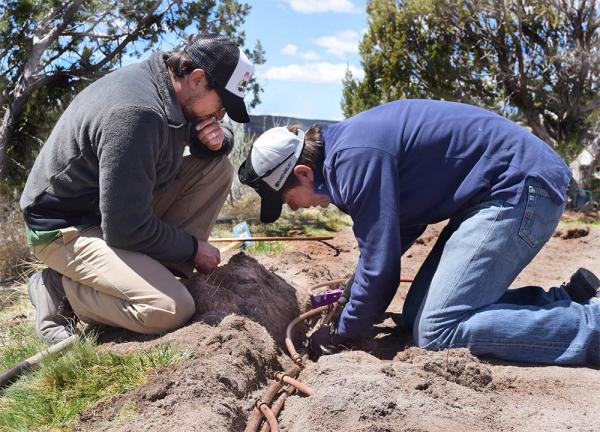Researchers in the New Mexico State University College of Agricultural, Consumer and Environmental Sciences are determining methods to improve irrigation efficiency. And subsurface irrigation may be the solution to wasted water and high water costs.
 NMSU extension turfgrass specialist Bernd Leinauer, Ph.D. said subsurface drip irrigation, in particular, is the newest method in turfgrass efficiency.
NMSU extension turfgrass specialist Bernd Leinauer, Ph.D. said subsurface drip irrigation, in particular, is the newest method in turfgrass efficiency."Although subsurface drip irrigation has been used in agriculture for decades, it's just making its way into the turfgrass industry," Leinauer said. "And it's the only system that limits irrigation to exactly the area that needs to be irrigated."
Leinauer has been the lead on two recent projects that will further test these research findings.
Last summer, Leinauer and his research team led a project to install a subsurface drip irrigation system in several tee boxes at The Club at Las Campanas in Santa Fe. The USGA awarded NMSU a grant to assist with the research, which is a collaboration that also includes Toro and Rain Bird.
It was announced in December that Leinauer and his team are conducting a study at the City of Albuquerque's Paradise Meadows Park. While half of the park will use a traditional pop-up sprinkler watering system, NMSU will oversee the other half of the park, where a subsurface drip irrigation system has been installed.
"This project is interesting from the perspective that we were able to scale up our research findings," Leinauer said. "We're able to take our research findings and implement them in a park which is significantly larger than test plots or the traditional residential turf areas. For the funding agencies that have supported our research in water conservation, it is particularly important to document that technology not only works in a research setting but can be successfully scaled up to real-world situations."
NMSU researchers and city officials in Albuquerque should learn whether the subsurface drip irrigation system helped conserve water.
In addition to irrigation efficiency, NMSU research also focuses on salt and drought tolerance. Leinauer said there's been a shift to new types of waters with higher salinity levels, such as saline ground water, treated effluent or recycled water.
"In the future, having grasses available that can tolerate higher salt concentrations in the water and in the soil will become paramount to keeping green grass in urban settings," Leinauer said. "Therefore, we need to screen for salt tolerance in addition to screening for drought tolerance in new grasses."
Leinauer's work doesn't end with research. An important factor is outreach and education. What good are the research findings if professional turfgrass managers don't know about them?
In October, Leinauer and fellow researchers educated homeowners, master gardeners, landscape managers and turfgrass professionals at the Southwest Turfgrass Association Recreational Landscape Conference and Expo hosted by NMSU. The conference included a field trip to the NMSU Turfgrass Salinity Research Center.
"With me being a board member of the Southwest Turfgrass Association, I am closely connected with the industry," Leinauer said. "I think such outreach activities represent some of the core work of an extension specialist. We need to work with the practitioners and the industry, so we always have a close ear on what the problems and the trends are outside the university. We can work closely with each other and design projects together. We can hopefully advance science through real-world applications."
The projects at The Club at Las Campanas and Paradise Meadows Park are in line with one of the college's outlook on economic development and conservation principles.

